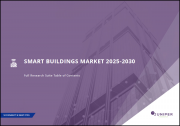
|
시장보고서
상품코드
1522945
세계의 스마트 빌딩 사이버 보안 혁신과 성장 기회Global Smart Buildings Cybersecurity Innovation and Growth Opportunities |
||||||
디지털화 테크놀러지 전략이 사이버 보안 솔루션의 채택을 촉진
생활공간이자 업무공간인 건물은 스마트하고 연결성이 강화되고 있습니다. 에너지 소비를 줄이고, 자립성을 높이고, 더 쾌적하게 만들려는 수요에 힘입어 다양한 새로운 시스템들이 스마트 빌딩 생태계에 진입하고 있습니다. 사물인터넷(IoT)을 통해 놀랍도록 많은 새로운 용도과 서비스가 실현되고 있습니다. 그러나 스마트할수록 사이버 공격에 취약해지며, IT/운영기술(OT) 네트워크가 융합됨에 따라 공격자가 악성코드를 설치하거나 데이터를 훔치고 시스템에 침입할 수 있는 기회는 몇 배나 더 많아졌습니다.
스마트 빌딩의 통합과 상호 연결이 증가함에 따라 강력한 사이버 보안 솔루션의 필요성이 가장 중요해지고 있습니다. 이러한 장비를 보호하고 무단 액세스 및 악용 가능성을 방지하기 위해서는 사이버 보안 솔루션이 필요합니다. 스마트 빌딩에는 에너지 관리 시스템, HVAC, 보안 시스템 등 중요한 인프라가 설치되어 있는 경우가 많습니다. 이러한 중요한 컴포넌트를 사이버 위협으로부터 보호하는 것이 스마트 빌딩 환경의 고유한 과제에 맞는 사이버 보안 솔루션에 대한 수요의 원동력이 되고 있습니다. 에너지, 국방, 공항, 의료, 정부 등의 부문은 사회 및 경제 기능에 필수적인 핵심 인프라이기 때문에 반드시 보호해야 합니다. 사이버 보안은 오늘날 디지털 중심의 세계에서 개인, 조직, 국가를 다양한 사이버 위협으로부터 보호하는 데 있으며, 매우 중요한 역할을 하고 있습니다. 사이버 보안은 현재 진행형으로 진화하는 과제이며, 새로운 위협에 한발 앞서 나가기 위해서는 지속적 인 노력과 교육, 투자가 필요합니다.
이 조사에서는 스마트 빌딩 산업에서 사이버 보안의 현황을 살펴봅니다. 잠재적 위험과 현재 관행을 파악하고 조사하여 스마트 빌딩 업계의 사이버 보안 채택 현황에 대한 의미 있는 결론을 도출합니다.
목차
전략적 필수 요건
- 왜 성장이 어려워지고 있는가?
- The Strategic Imperative 8(TM)
- 스마트 빌딩 업계에서 사이버 보안에 대한 주요 전략적 필수 요건의 영향
- Growth Pipeline Engine(TM)을 촉진하는 성장 기회
성장 기회 분석
- 분석 범위
- 빌딩의 진화
- 스마트 빌딩의 사이버 보안
- 스마트 빌딩에서 사이버 공격의 잠재적 리스크 영역
- 스마트 빌딩에서 사이버 보안의 현황
- 스마트 빌딩에서 사이버 보안의 필요성
- 성장 촉진요인
- 성장 억제요인
- 스마트 빌딩용 사이버 보안 서비스
- 스마트 빌딩용 사이버 보안 : 지출과 성장 예측
- 스마트 빌딩용 사이버 보안 : 지역 지출
- 스마트 빌딩용 사이버 보안 : 우려 리스크 분석
- 스마트 빌딩용 사이버 보안 : 업종별 시장 리스크 분석
- 사례 연구 : Target Corporation
- 사례 연구 : BAS 기업
- 사례 연구 : Dallas Healthcare Building
- 사례 연구 : Las Vegas Casino
- 사례 연구 : Residential Buildings
- 스마트 빌딩용 사이버 보안 : 솔루션 프로바이더 에코시스템
- 베스트 프랙티스와 사용 사례
주요 기업의 개요
- ABB
- Accenture
- AtoS Group(Eviden)
- Deloitte
- Fortinet
- Honeywell
- JCI
- Microsoft
- SE
- Siemens
성장 기회 유니버스
- 성장 기회 1 : 사이버 보안 채택용 업종별 우선순위 결정
- 성장 기회 2 : 파트너십과 M&A에 의한 사이버 보안의 발전
- 성장 기회 3 : 사이버 보안을 추진하는 새로운 비지니스 모델
- 별지 리스트
- 면책사항
Technology Strategy in Digitalization to Spur Adoption of Cybersecurity Solutions
The buildings that we live and work in are getting smarter and more connected. Driven by the demand to reduce energy consumption and make buildings self-sustainable and more comfortable, a wide range of new systems are entering the smart building ecosystem. A staggering number of new applications and services are enabled thanks to the Internet of Things (IoT). However, the smarter a building becomes, the more susceptible it is to cyberattacks. With increasing convergence between IT/operational technology (OT) networks, the opportunity for attackers to place malware, steal data, or hack into systems increases several manifolds.
As smart buildings become more integrated and interconnected, the need for robust cybersecurity solutions becomes paramount. It requires cybersecurity solutions to secure these devices, preventing unauthorized access and potential exploitation. Smart buildings often house critical infrastructure, including energy management systems, HVAC, and security systems. Protecting these critical components from cyberthreats is a driving force behind the demand for cybersecurity solutions tailored to the unique challenges of smart building environments. Because sectors like energy, defense, airports, healthcare, and government are all critical infrastructures essential for the functioning of society and the economy, they need to be well protected. Cybersecurity plays a crucial role in protecting individuals, organizations, and nations from the various cyberthreats that exist in today's digitally driven world. It is an ongoing and evolving challenge that requires continuous efforts, education, and investment to stay ahead of emerging threats.
This study provides an overview of the current state of cybersecurity in the smart buildings industry. It identifies and explores the potential risks and current practices, and derives meaningful conclusions about the state of cybersecurity adoption in the smart building industry.
Table of Contents
Strategic Imperatives
- Why Is It Increasingly Difficult to Grow?
- The Strategic Imperative 8™
- The Impact of the Top 3 Strategic Imperatives on the Cybersecurity in the Smart Buildings Industry
- Growth Opportunities Fuel the Growth Pipeline Engine™
Growth Opportunity Analysis
- Scope of Analysis
- Evolution of Buildings
- Cybersecurity in Smart Buildings
- Potential Risk Areas for Cyberattacks in Smart Buildings
- State of Cybersecurity in Smart Buildings
- Need for Cybersecurity in Smart Buildings
- Growth Drivers
- Growth Restraints
- Cybersecurity Services for Smart Buildings
- Cybersecurity in Smart Buildings: Spending and Growth Forecasts
- Cybersecurity in Smart Buildings: Regional Spending
- Cybersecurity in Smart Buildings: Areas of Concern Risk Analysis
- Cybersecurity in Smart Buildings: Vertical Market Risk Analysis
- Case Study: Target Corporation
- Case Study: BAS Firm
- Case Study: Dallas Healthcare Building
- Case Study: Las Vegas Casino
- Case Study: Residential Buildings
- Cybersecurity in Smart Buildings: Solution Provider Ecosystem
- Best Practices and Use Cases
Profiles of Key Companies
- ABB
- Accenture
- AtoS Group (Eviden)
- Deloitte
- Fortinet
- Honeywell
- JCI
- Microsoft
- SE
- Siemens
Growth Opportunity Universe
- Growth Opportunity 1: Vertical Sector Prioritization for Cybersecurity Adoption
- Growth Opportunity 2: Cybersecurity Development through Partnerships and Mergers & Acquisitions
- Growth Opportunity 3: New Business Models in Advancing Cybersecurity
- List of Exhibits
- Legal Disclaimer



















